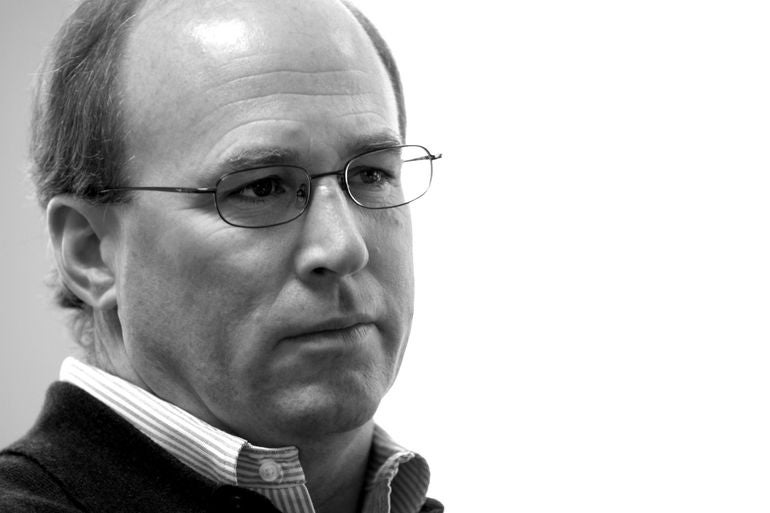Built for the long term | Reed & Reed made its name building bridges, but now the Woolwich-based construction company sees its future in the wind
Jackson Parker remembers looking over a wind turbine array while vacationing with his wife, Susan Reed, in northern California in the 1980s, and thinking, “We could do something like that.”
Just a few years into his tenure as president and CEO of Reed & Reed at the time, it would be almost two decades before Parker had a chance to apply his idea to an actual wind project. In the interim, Reed & Reed was selected in the early 1990s to build the Kenetech wind project in Maine’s western mountains. The 300-tower project was permitted but never built after Kenetech filed for bankruptcy.
The current generation of wind power construction appears to be on much firmer footing. The Woolwich-based construction company successfully won a $10 million project in Massachusetts this summer, enhancing its reputation as the premier wind project builder in New England.
Its expertise began when Reed & Reed was picked to build the first industrial-scale wind farm in Maine, on Mars Hill for First Wind (formerly UPC), and finished the job on time and within budget in 2006.
Not that it was easy, says Tom Reed, Parker’s partner in the business who serves as field manager. “We struggled to get that job done,” he says. New construction techniques, a mountaintop environment that was very different from the company’s signature bridge work environs, and the challenges of wind and weather made for a steep learning curve. “But in the end, we made money on the job,” Reed says.
Since then, Reed & Reed has built the Lempster Wind Farm in Webster, N.H., in 2008 for Iberdrola, Central Maine Power Co.’s parent company, and also built the Stetson 1 and Freedom projects in Maine — the three projects are valued at $160 million.
Reed & Reed is currently at work on the Kibby Mountain site for TransCanada, its largest contract to date at 132 megawatts and $320 million, and not far from the original Kenetech site. It has also begun construction on turbines for the Berkshire Wind Power Cooperative, the first large-scale project approved in Massachusetts that was awarded in July.
“So far, we’ve been the lead contractor on every major project in New England,” says Parker. “We know that’s not going to continue, but we intend to continue bidding on every job that’s feasible for us.”
Story continues after the table
Not surprisingly, the company’s revenues have soared, from $63 million in 2007 to a projected $102 million this year. The work force has grown, too, up to a record 250 employees despite the nationwide recession.
While Parker says that the expansion into wind power was an attempt to diversify and take advantage of a new opportunity, the company’s traditional portfolio remains strong, including bridges, parking garages and marine construction.
A bankable beginning
Reed & Reed was founded in 1928 by Carlton Day Reed with the financial assistance of his father, Captain Josiah Reed — hence the corporate name — on the banks of the Kennebec River in Days Ferry, a small village in Woolwich. The company is still headquartered there, and most of the principals live there, as well.
The 1930s were good to the company, as New Deal legislation authorized numerous public works projects. Reed & Reed began growing and was soon building bridges all over the state.
Carlton “Bud” Reed took over the company from his father in the 1950s, and ran it until his retirement in the 1980s. The company built several of the major interstate highway bridges, including crossings of the Androscoggin River — up to that time the largest such contracts in the state.
Jackson, or Jack, Parker joined the family when he married his college classmate, Susan Reed, shortly after both graduated from Colby College. He took a job in Chicago, but, soon after the birth of their first child, they decided to return to Maine and Parker accepted a job with Reed & Reed in 1982. Three years later, he was offered the president’s position. It’s a measure of the stability of the third-generation family firm that Parker refers in passing to “my short tenure here.”
Tom Reed, the son of Bud Reed, is a decade younger than Parker — and also a Colby graduate, like 18 other family members, and has always preferred the job site to the office. A co-owner, he says, “I’d like to spend all my time in the field.”
In 2005, Reed was superintending the final phases of the Penobscot Narrows Bridge, a joint project for a cable-stay span with Pittsfield rival Cianbro that was built in near-record time after the previous suspension bridge cables were found to be badly deteriorated. Then he headed up to Mars Hill for the beginning phases of the first wind power project, perhaps not knowing what an omen of future work it would be.
Reed & Reed rented a crane to hoist the massive generating units needed for the towers, but that was only a trial run. “You cover your costs, but that’s about it,” Reed says.
For the buildup it anticipates in wind tower construction, the company purchased two 440-ton cranes capable of lifting 160,000-pound generating units, at a cost of $4 million apiece. “We like cranes,” Parker says, gesturing at a model beside his desk.
Currently, Tom Reed splits his time between a $24 million replacement of the “covered bridge” in Norridgewock (a reference to its unusual concrete superstructure) for Maine Department of Transportation, and TransCanada’s Kibby Mountain wind farm.
The construction details of contemporary wind turbines are mind boggling. The towers themselves measure 265 feet high and support 120-foot blades turning far more slowly than the windmills Parker glimpsed two decades ago in California. After installing GE turbines at Mars Hill and Stetson, the Kibby project features even larger components manufactured by Vestas, the Danish wind power leader. They arrived on ships from Europe at Searsport and Eastport, where over-land transit begins.
Despite the considerable logistical issues, the work has gone smoothly, Parker says, “safely, with a high standard of quality, on time, and on budget.” He notes there has yet to be a lost-time accident amid 175,000 work hours logged.
Reed & Reed has learned a lot about how to organize a wind power project since Mars Hill. Keeping all the pieces of the puzzle in place, and arriving on schedule, are probably the biggest challenges, he says.
Occasionally, the company’s projects do not go according to plan. Tom Reed recalls the construction of the Casco Bay Ferry Terminal in Portland back in the 1980s, when the design called for driving cement pilings to support the structure — a process every bit as difficult as it sounds. “We tried to get the design changed, but we couldn’t,” he said. “There are ways to do it, but we learned that the hard way.”
While the wind power emphasis has led Reed & Reed’s recent growth, bridge construction is also making a comeback, thanks in part to Maine DOT’s Transcap program. Responding to projections that the state was replacing bridges at only a quarter of the rate they were wearing out, the Legislature increased vehicle license, registration and title fees to fund a new five-year program. One result is the new Veterans Bridge on Route 1 between Portland and South Portland, a $60 million contract Reed & Reed expects to bid on this fall.
As for future revenues, “We don’t have a goal,” Parker says. Growth “is not an end in itself,” he adds. It’s more important to “be good at everything we do, and budget in a conservative fashion.”
One example of this approach was the 2006 decision to shut down the Caribbean subsidiary Reed & Reed had used for 15 years, because growth opportunities in wind power appeared more significant.
Reed & Reed is different from its larger, Maine-based competitors, who seek out projects across the country. “Essentially, they need satellite offices wherever they operate,” Parker says. Reed & Reed intends to remain a Maine-based company operating throughout New England. “There are companies like ours in every other region of the country,” he says. “We have no intention of trying to compete with them.”
That doesn’t mean there isn’t plenty of competition in the New England market already. Reed noted that Pittsfield-based Cianbro, already a competitor for bridges, is also building its first wind farm, a relatively small installation of three GE turbines on Vinalhaven.
Reed’s take on the company’s performance is parallel, but distinct, from Parker’s.
He emphasizes the value of teamwork among the company’s many longtime employees, and its practice of promoting from within. “Over the last five years, we’ve found that some of our best hires were people who were already working here, and were ready for a new opportunity.” A successful construction company, Reed says, “is never the result of one person’s effort, but the skills of the entire work force.”
Those skills have been growing since completion of the Mars Hill project, to the point where different employees have become specialists. That’s one reason Parker is optimistic that Reed & Reed will continue to get a significant number of wind farm contracts, no matter how many competitors enter the field. “We have a leg up, and we intend to use it,” he says.
With respect to offshore wind power — where Maine is considered to have huge potential — Parker displays the caution of a construction executive rather than the enthusiasm of a researcher. “The technology isn’t ready for production yet,” he says. “It isn’t going to attract investment capital because the numbers aren’t there.” With that said, though, if the technology does mature, “We intend to be right there,” he says.
Managing for the future
Though acutely conscious of Reed & Reed’s history and traditions — Parker’s daughter, Abigail, published a company history called “Building on a Legacy” in 2005 — he is unsentimental about the prospect for a fourth generation of family in the business.
“There’s this misconception about family companies, that if you have the correct last name, it’s an assurance of some level of ability.” Every employee, he said, ultimately has to meet the same tests. “If you can’t lead and perform, your competition will drive you into the ground.”
The real secret to longevity in business, he said, is that “people want to be part of a successful organization, and to be able to contribute to it.” He sees his own role as “building on the strengths of a company that had already enjoyed great success.”
Parker says he enjoys the challenges of working on public projects, many of which are one-of-a-kind, like the signature bridges Reed & Reed has always built.
One of the necessary steps is to convince the guarantors of the project — bonding companies and rating agencies — that Reed & Reed has the financial capability and a plan to complete work successfully. “They always want to know what, exactly, the project is going to look like. These days, I don’t always know what it’s going to look like, to be honest,” he says. “But I do know that we’re going to get there.”
Doug Rooks, a writer based in West Gardiner, can be reached at editorial@mainebiz.biz.














Comments